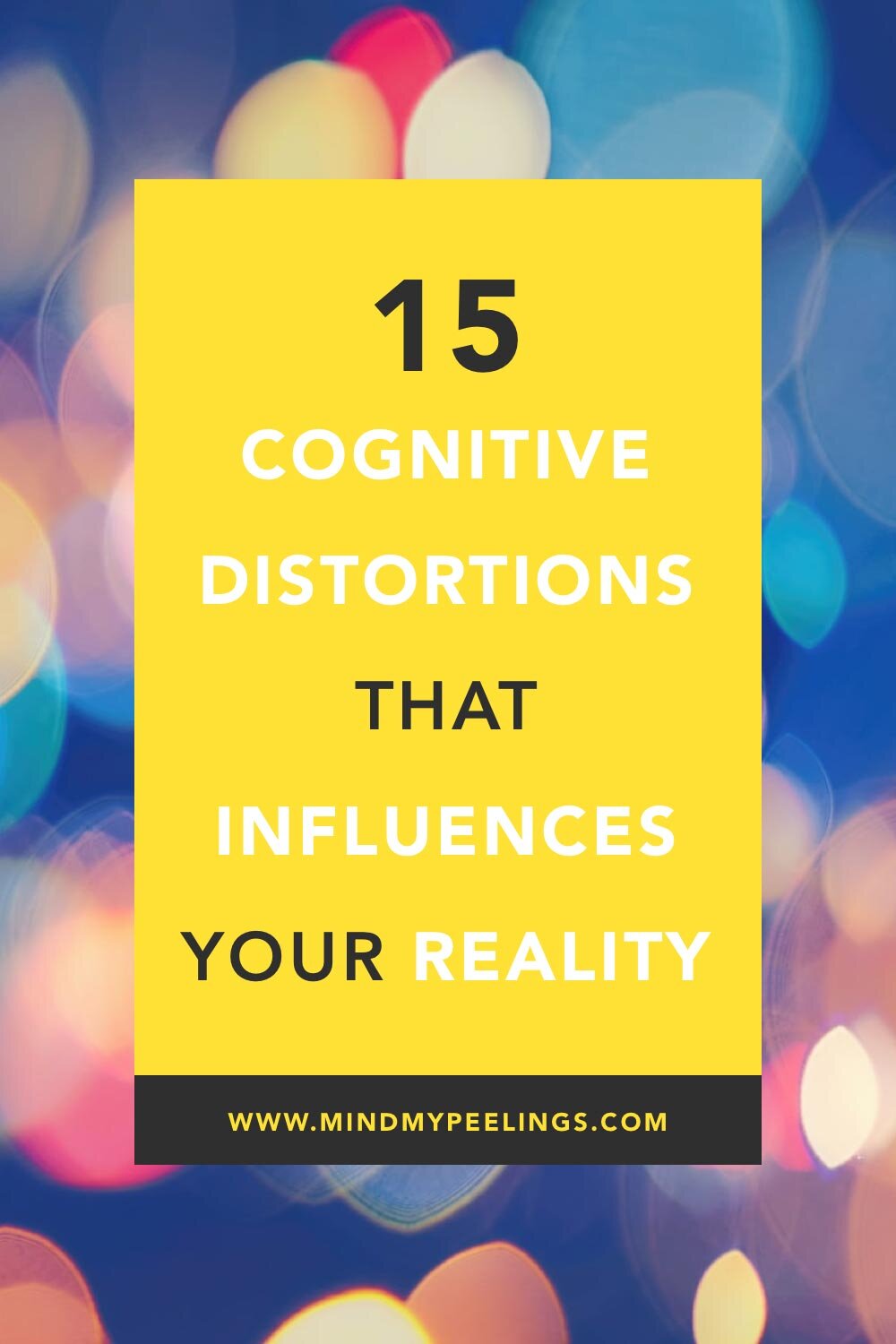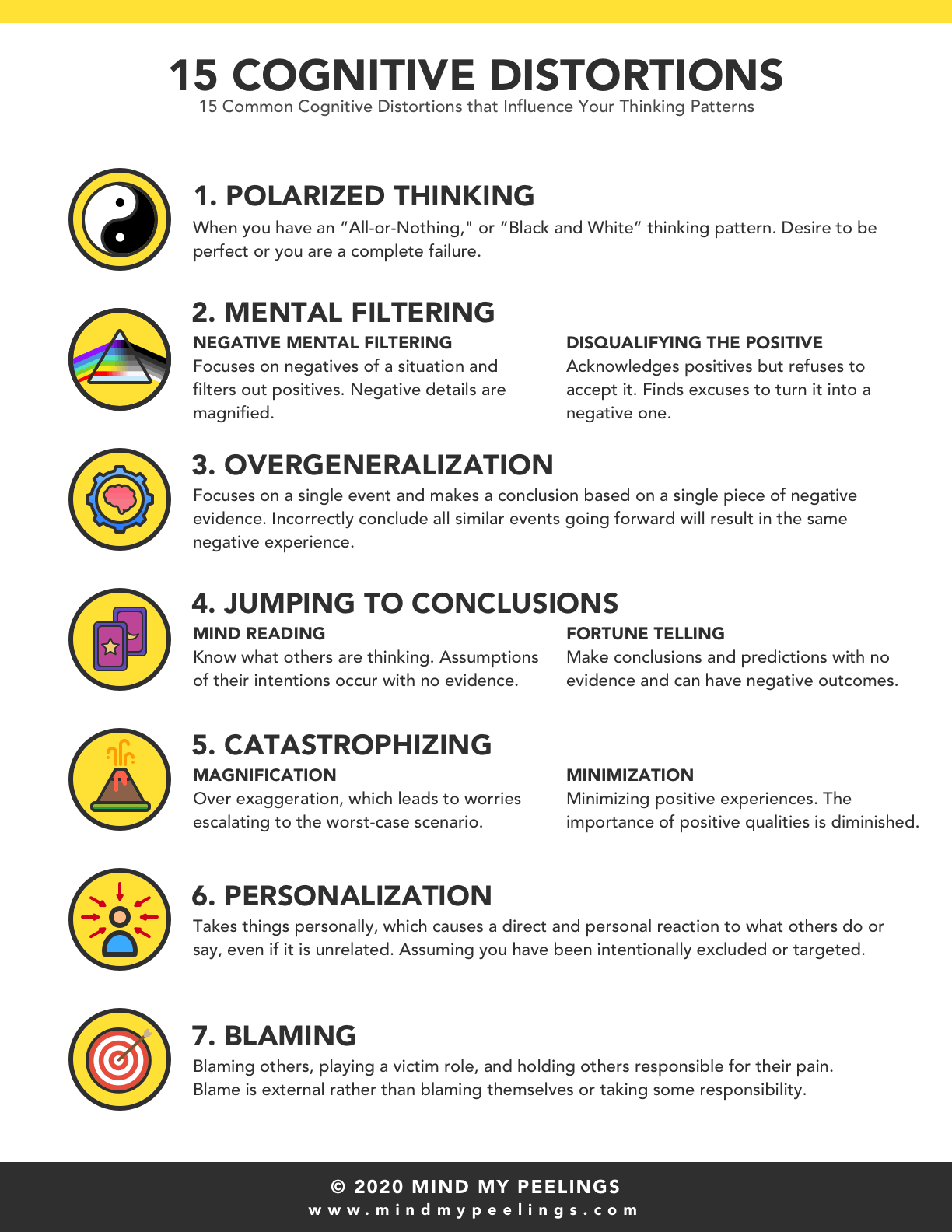How Cognitive Distortions Creates an Irrational Perception of Reality
Everyone experiences cognitive errors on a day-to-day basis. However, if you are guilty of being stuck in a thinking trap and negatively distorting reality, you are not alone.
These negative thought patterns or habits make us exaggerate or inaccurately perceive reality in an unhealthy way. This can be damaging to our mental health, relationships, and wellbeing.
Learn about the different types of cognitive distortions, how they affect you, and what you can do to overcome each one.
Understanding Cognitive Distortions
Cognitive distortions were first understood when Aaron Beck connected distorted thinking patterns with his patients struggling with depression. He hypothesized that changing their thinking would change their symptoms.
It was David Burns who help popularized the approach to treating depression by focusing on identifying, correcting, and replacing distorted systems and thinking patterns.
His book, Feeling Good - The New Mood Therapy, outlines his approach to treating depression and is often recommended by therapists to their patients.
Burns identified many of the different types of thought distortions that we are familiar with today. We will go through the list of common thinking traps and provide you with examples to help you understand each of them.
What is a Cognitive Distortion
Cognitive distortions are irrational thought patterns that are exaggerated by negative thinking and feelings. They convince our minds what we’re thinking is true.
These common thought patterns occur automatically in our normal day-to-day thoughts. This makes them difficult to recognize, as their habitual nature is wired into our brains.
Our brains tend to take short cuts. It remembers things from our past and will tend to take that same connection when similar thoughts or emotions occur. This is good for helping us remember things but can be dangerous for negative thoughts and emotions such as anxiety or depression.
If the thought distortions are reinforced often enough due to our habitual thinking, it can lead to an increase in anxiety, depression, and unhealthy relationships.
It is important to recognize that all cognitive distortions are:
Habitual patterns of thinking or beliefs
False, inaccurate, and often exaggerated thoughts
Manifest itself as negative emotions or feelings
May increase anxiety and depression, potentially causing psychological damage
What Causes Distorted Thinking
There is little evidence to suggest that cognitive distortions are caused by depression or anxiety. However, it is known that cognitive distortions are more prevalent in those who suffer from depression, anxiety, or other severe mental illnesses.
A downward depressive spiral can be one of the triggers that cause a person to be trapped in these distorted thoughts.
Cognitive Distortions are part of a complex system that is intertwined with our thoughts, behaviors, and emotions. They do not have a single root cause, like depression and anxiety there isn’t one underlying reason which is the cause.
There are several factors such as cultural, environmental, and social factors that could influence negative thought patterns.
Cultural Factors
language, religion, customs, beliefs, and moral values all have an influence on our behavior in both positive and negative ways
is learned and passed on through generations
influences the way we dress, behave, communicate, and how you handle emotions
creates a competition vs cooperation mindset
impacts your willingness to speak about a mental illness or seek help
Environmental Factors
genetics, financial wealth, education level, and living conditions can influence your sense of security, resilience, persistence, and attitude
accessibility to health care and other health services offers more opportunity for increased longevity and decreased stress
Social Factors
stigma from peers and the media influences our ideas, beliefs, the way we think, and how we perceive ourselves or others
parental guidance contributes to your overall behavior and attitude
negative social relationships can lead to an “Us vs Them” mentality
positive relationships can promote healthy communication and emotional wellbeing
your active participation in social activities can contribute to mental wellness
All these factors contribute to how we are brought up and affect our thoughts, behaviors, and emotion towards events in our lives.
Who is Affected by Cognitive Thinking Errors
Everyone can experience irrational thinking patterns in their day-to-day thoughts. However, most won’t be affected negatively and will be able to recognize irrational thoughts quickly.
For those who struggle with stress or anxiety, these distorted thoughts feel real. This makes it difficult to recognize that these thoughts are irrational.
Our minds are on autopilot when we experience those cognitive distortions. We don’t realize it’s happening and that is what makes it so difficult to recognize that the thoughts are inaccurate and illogical.
How Cognitive Distortions Affect You
Everyone experiences some form of cognitive distortion from time to time. The difference is some can recognize fairly quickly that the errors of thinking are irrational and can bring themselves back to reality.
Others may have difficulty recognizing what they are thinking is false and inaccurate. If they are reinforced often enough, they can increase anxiety, deepen depression, cause relationship difficulties, and lead to a host of other complications.
How Negative Thoughts Influence Emotions
We tend to conclude that the feelings and emotions that occur are due to an event or something that happened.
We focus solely on the fact that “This happened to me and it made me feel this way”. However, we forget that we don’t jump from an event in our life to an emotion or feeling.
There is something in between that has just as much influence, or even more, on how we feel about that event. That is the role of thoughts and internal dialogue. We tend to skip over our thoughts because most of us are on autopilot and our thoughts are fleeting.
Our thought patterns have a significant influence on the emotions and feelings due to an event that occurred. The negative thoughts, or cognitive distortions, that intrude our mind are causing feelings and emotions such as being anxious or worrying.
Learn to challenge those worries or anxious thoughts by questioning them.
Now that we understand our thoughts can dictate our mood, we can change our mood by first changing our thoughts.
By managing our thoughts in a positive way, we can recognize negative thinking and move towards automatically influencing how we feel and improve our mental wellbeing.
By familiarizing ourselves with the common cognitive distortions list, we can identify negative thoughts and patterns to avoid negative thinking traps altogether.
15 Common Cognitive Distortions
Let’s take a look at a list of the 15 styles of distorted thinking that commonly affect us. Examples of thinking errors are also given for each of the distorted thinking styles to help you understand clearly how each of them affects you.
1. Polarized Thinking
Polarized thinking is when you have an “All-or-Nothing," or “Black and White” thinking pattern.
A person with polarized thinking believes they have to be perfect or they are a complete failure because they see things in terms of “either/or” categories.
There is no middle ground that allows for the complexities of realistic thoughts. A person with black and white thinking only thinks in extremes.
Polarized Thinking Example
A student who gets an A- on an exam feels like a failure because they are used to getting A+ grades only. They have the mentality, “If I am not successful at everything I do, I am a complete failure”.
2. Mental Filtering
Mental filtering consists of two types of distortions. Both occur when a person focuses solely on the negative aspects of an experience.
Negative Mental Filtering
Negative Mental Filtering is when a person focuses on the negatives of a situation and filters out all the positives aspects. They will magnify those negative details and dwell on those feelings.
Their vision of reality can become darkened and distorted due to their focus on the negatives. This prevents you from seeing things clearly as you are focused on what’s not working, rather than what is working.
Negative Mental Filtering Example
An employee who receives a performance review at work gets a good review but focuses on one negative comment their manager made about them during the review.
Disqualifying the Positive
This differs from Negative Mental Filtering in that this distortion acknowledges the positive experiences but refuses to accept it. Disqualifying the Positive is a complete rejection of positive experiences.
The person will invalidate and ignore the positives while finding excuses to turn it into a negative one. This occurs even though there is clear evidence that it is positive.
Disqualifying the Positive Example
A student gets a good grade on an assignment, but the student overlooks it and tries to explain their good grade as simply luck or fluke instead of a result of their hard work.
3. Overgeneralization
Overgeneralization thinking occurs when a person focuses on a single event that occurred and makes a conclusion based on this single piece of negative evidence.
Since they reached this conclusion from the single event, they incorrectly conclude all similar events going forward will result in the same failure or negative experience.
Overgeneralization Example
A student receives a bad grade on one exam, based on this they think they are stupid and a failure and believe that all future exams they will get a bad grade as well.
4. Jumping to Conclusions
There are two types for this distortion, both consist of jumping to conclusions and making assumptions that are not based on any actual evidence.
Mind Reading
This distortion occurs when you think you know what the other person is thinking. You assume what other people’s reasons or intentions are and take that interpretation as the only valid reasoning.
This is done purely out of assumptions and generally with little or no physical evidence. In reality, there could be many possibilities but you won’t acknowledge them.
Mind Reading Example
When you are spending time with a friend, but they seem distracted or uninterested. You automatically jump to the conclusion that it has something to do with you. There could be many reasons, unrelated to you, why they are feeling that way.
Fortune Telling
Fortune Telling is similar to mind reading in that it is purely based on your assumptions. This distortion is when you make conclusions and predictions based on little or no evidence. The prediction is generally arbitrary and has a negative outcome.
Fortune Telling Example
You have a date with a wonderful person but you predict that the date will go bad. You start making assumptions about how the date will go before it even has occurred. The predictions are not based on any actual evidence.
5. Catastrophizing
Catastrophizing thoughts occur when the magnitude is exaggerated or diminished.
Magnification
Magnification is an over-exaggeration of a thought. This type of thinking leads to worries escalating quickly and becoming the worst-case scenario. Magnification can occur when there are unknowns that a person can’t control.
Magnification Example
A person is meeting a date for lunch. However, their date is running late and the person starts assuming the worst. Their worries escalate quickly and the thoughts become exaggerated when there could be many reasonable explanations why a person is late.
Minimization
Opposite of magnification, this cognitive distortion consists of minimizing positive experiences. The magnitude of importance for positive qualities is diminished when this distortion occurs.
Minimization Example
An athlete wins an award but does not acknowledge their accomplishment. They minimize the importance of the award because they might feel others already have the same award.
6. Personalization
When engaging in this type of distortion, an individual will take things personally. This will cause a direct and personal reaction to everything others do or say even if it was unrelated to them.
Self-blame for circumstances beyond your control could also occur as well as assuming you have been intentionally excluded or targeted.
Personalization Example
You attend a party but all your friends are busy engaging with other people. You feel like they do not have any interest in being your friend and engaging in conversation with you. This makes you think you don’t belong or are unfairly excluded.
7. Blaming
This mind trap consists of blaming others for their problems. It is different from Personalization in that the person directs the blame externally.
Rather than blaming themselves or taking some responsibility, they tend to play a victim role and hold other people responsible for their pain.
Blaming Example
Placing blame for relationship issues on your partner instead of sharing the responsibility for actions taken by both partners. You assume the victim mentality and think everything they do is to hurt you.
8. Labeling
Labeling is an extreme form of Overgeneralization. When this type of thinking occurs, you assign judgment to yourself or others based on one negative occurrence or incident.
Instead of recognizing you or others made a mistake, you attach a label to it. This mislabeling of the situation is generally exaggerated and is solely based on that single incident.
Labeling Example
You ask a colleague for help with a task you are working on. Your colleague quickly dismisses your attention and does not help you. Based on this you assume they are a selfish jerk. However, they could be swamped with work and have immediate deadlines, and is feeling the pressure. They react negatively to you asking for help but you do not realize the pressure and stress they are under.
9. Always Being Right
This thinking pattern causes a person to always have the need to be right. They internalize their opinions as facts and will put others on trial to prove that their own opinions or actions are the correct ones.
Being wrong is not acceptable and they will go to great lengths to demonstrate their belief.
Always Being Right Example
Two people at work have a disagreement about how one technical part of the project should be executed. One person believes it should be done their way because that’s how it’s always been done. But the other argues based on facts that there are industry-standard procedures that need to be followed. The person completely ignores these facts and argues their opinion to any extent.
10. Should Statements
This distortion is statements of what a person “should” do, “must” do, or even “shouldn’t” do. The statements are enforced on themselves or others.
These rules create a lot of pressure, imposing a set of expectations that is not likely to be met. Feelings of guilt, frustration, and even anger or resentment could occur from disappointment.
Should Statements Example
Statements like, “I should be exercising more," create expectations that are not likely to be met. The pressure created from the “should” statements makes it difficult to meet those expectations and when the failure occurs there is guilt and frustration which makes you less likely to make another attempt.
11. Emotional Reasoning
Whatever emotion a person is feeling during this thought distortion must be true in their mind. One’s emotion is accepted as fact because all logical reasoning is blocked out.
They are incorrectly assuming that the negative feeling brought out by their emotions is the only truth.
Emotional Reasoning Example
You might feel lonely because at this moment you are by yourself and your friends are off doing something fun. However, from this feeling, you assume no one loves you or wants to be around you.
12. Control Fallacies
The control fallacy cognitive distortion is defined by two beliefs, external and internal control fallacies.
External Control Fallacy
External Control is the belief that a person’s life is completely controlled by external factors and fate has already been decided. This distortion creates the feeling they have absolutely no control over their situation.
External Control Fallacy Example
A person cheats and lies to their partner, when they leave they feel that it is all the other person's fault for leaving. They think that they had no control over what happened but they fail to see how their actions affected what happened to them.
Internal Control Fallacy
Internal Control is the belief that a person has complete control of themselves and their surroundings. This belief assumes you are responsible for the pain and happiness of those around you. If someone isn’t happy, they will assume it was their fault.
Internal Control Fallacy Example
A colleague made a technical error on a task at work. This mistake created severe consequences for other tasks. You feel guilty and responsible because when you reviewed their work you missed the mistake.
13. Fallacy of Change
This thought distortion assumes that others should change to suit their own interests.
The person will pressure others to change because they feel the change will bring them happiness. They are convinced the happiness is dependent on the person changing.
Fallacy of Change Example
A person might pressure their partner to change a few of their manners. They believe their partner is perfect in every other way except those few minor things and expects those changes will make them even happier.
14. Fallacy of Fairness
Fallacy of Fairness assumes that all things in life should be applied and measured based on fairness and equality.
However, in reality, not all things work out the way we expect them to and we will feel angry and resentful towards those things in life.
Fallacy of Fairness Example
A person who struggles with low income might feel anger and resentment towards others who make more money than them. They might feel that they work just as hard if not harder than other people but are not rewarded the same. What the person fails to realize is that others who make more income could have different educational backgrounds with different types of jobs.
15. Heaven’s Reward Fallacy
This belief is related to the Fallacy of Fairness, in that if we lived in a fair world we would be rewarded fairly. Heaven’s Reward Fallacy distortion is based on the reasoning that you should be rewarded based on how hard you work.
Similar to the Fallacy of Fairness, we will be disappointed because most things in reality aren’t fair. This leads to feelings of frustration, anger, and resentment.
Heaven’s Reward Fallacy Example
You were expecting to get a promotion this year because of your hard work. You believe you worked harder than the rest of your colleagues but you didn’t get the promotion. You feel resentment towards your colleague because you believe you should have been rewarded for your hard work. However, there could have been many reasons why they were promoted over you, hard work isn’t the only consideration.
Cognitive Distortions Infographic
List of Cognitive Distortions Infographic
Being aware of the cognitive distortions and how they affect your thinking is critical to overcoming negative thinking.
Download a free printable copy of the list of cognitive distortions pdf and start recognizing thinking traps today.
Examples of Cognitive Distortions Infographic
Download a printable copy of examples of the common cognitive distortions to better understand each of the negative thinking styles.
Overcoming Cognitive Distortions
If a person can correctly identify these negative thinking errors, it allows them the opportunity to challenge and refute those negative thoughts.
By continually challenging those thoughts over and over again, the habitual tendency towards cognitive distortions will begin to diminish. Over time, your thoughts will automatically be replaced by more rational thinking.
This altering of negative thinking is known as Cognitive Restructuring and is a core fundamental of Cognitive Behavioral Therapy (CBT).
Follow these steps to build that awareness and start identifying your cognitive distortions:
Print and read through the list of thinking errors to familiarize yourself with each one
The next time you experience a thinking error, stop and pause for a moment, focus on what you we’re thinking about
Refer to the list and identify the distortion that applies to your thought
Repeat this every time, you may not be able to identify the distortion every single time, but as to practice you will get better at recognizing it
Overcome the cognitive distortion by challenging and reframing your thoughts
This article focuses on what the cognitive distortions are, familiarizing yourself with them, and building awareness to identify them when they occur. This is outlined in the first 4 steps above.
The last step, step 5, is most likely why you are here. Now that you understand what the common types of distortions are and how they affect you, you can move on to the next step.
This step itself is a complete process. It will teach to challenge those cognitive distortions and reframe them in a positive way. With practice, you will begin to recognize the distortions automatically and be able to overcome them without much difficulty.
Learn to correct your thinking with these 6 steps to challenge automatic negative thoughts.





















